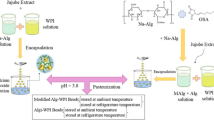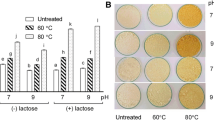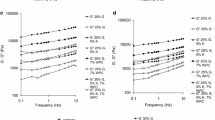Abstract
Water retention and thermostability of powders and films of whey protein isolate (WPIp, dWPIf), sodium alginate (NaALGp, NaALGf), and their dry hydrospheres were evaluated by thermogravimetric analysis to demonstrate the importance of the gelling cation, for the first time in the case of the protein, and some potential applications. WPIp retained less water (7.1%) than ALGp (20.4%) due to the greater hydrophilicity of the polysaccharide. The difference was smaller for the films (12.3% and 18.8%, respectively) due to the incorporation of water during protein denaturation. Dried ALG beads retained less water than the film and the water content was dependent on the crosslinking cation (CaALGs > ZnALGs > CdALG). Protein films and spheres exhibited water retention very similar to CaALGs. The degradation of ZnALGs (smallest radius cation used and monodentate coordination) began at the lowest temperature (168 °C) and exhibited the highest mass loss as compared to CaALGs (171 °C) or CdALGs (176 °C, both with bidentate coordination). For the protein, Zn2+ also exhibited the lowest degradation peak temperature. Pyrolisis of powders, films and spheres demonstrate that the protein is more stable than the polyssacharide. Therefore, it can act as a better flame retardant agent than alginate. On the other hand, only alginate spheres were suitable for the production of activated carbon (190.0 m2 g−1) and the recovery of metal oxides.




Similar content being viewed by others
Change history
27 October 2021
A Correction to this paper has been published: https://doi.org/10.1007/s10973-021-11100-x
References
Chandel AK, Garlapati VK, Singh AK, Antunes FAF, Silva SS. The path forward for lignocellulose biorefineries: bottlenecks, solutions, and perspective on commercialization. Bioresour Technol. 2018;264:370–81. https://doi.org/10.1016/j.biortech.2018.06.004.
Alavi F, Emam-Djomeh Z, Yarmand MS, Salami M, Momen S, Moosavi-Movahedi AA. Cold gelation of curcumin loaded whey protein aggregates mixed with k-carrageenan: impact of gel microstructure on the gastrointestinal fate of curcumin. Food Hydrocoll. 2018;85:267–80. https://doi.org/10.1016/j.foodhyd.2018.07.012.
Zhang J, Ji Q, Wang F, Tan L, Xia Y. Effects of divalent metal ions on the flame retardancy and pyrolysis products of alginate fibres. Polym Degrad Stabil. 2012;97:1034–40. https://doi.org/10.1016/j.polymdegradstab.2012.03.004.
Huq T, Salmieri S, Khan A, Khan RA, Le Tien C, Riedl B, Fraschini C, Bouchard J, Uribe-Calderon J, Kamal MR, Lacroix M. Nanocrystalline cellulose (NCC) reinforced alginate based biodegradable nanocomposite film. Carbohydr Polym. 2012;90:1757–63. https://doi.org/10.1016/j.carbpol.2012.07.065.
DeCicco JM. Methodological issues regarding biofuels and carbon uptake. Sustainability. 2018. https://doi.org/10.3390/su10051581.
Zhao H, Yan H, Dong S, Zhang Y, Sun B, Zhang C, Ai Y, Chen B, Liu Q, Sui T, Qin S. Thermogravimetry study of the pyrolytic characteristics and kinetics of macro-algae Macrocystis pyrifera residue. J Therm Anal Calorim. 2013;111:1685–90. https://doi.org/10.1007/s10973-011-2102-8.
Ross AB, Anastasakis CH, Westwood A, Jones JM, Crewe RJ. Influence of cation on the pyrolysis and oxidation of alginates. J Anal Appl Pyrol. 2011;91:344–51. https://doi.org/10.1016/j.jaap.2011.03.012.
Liu Y, Zhao J, Zhang C, Ji H, Zhu P. The flame retardancy, thermal properties, and degradation mechanism of zinc alginate films. J Macromol Sci B. 2014;53:1074–89. https://doi.org/10.1080/00222348.2014.891169.
Pathak TS, Yun J-H, Lee S-J, Baek D-J, Paeng K-J. Effect of cross-linker and cross-linker concentration on porosity, surface morphology and thermal behavior of metal alginates prepared from algae (Undaria pinnatifida). Carbohydr Polym. 2009;78:717–24. https://doi.org/10.1016/j.carbpol.2009.06.011.
Liu Y, Zhao X-R, Peng Y-L, Wang D, Yang L, Peng H, Zhu P, Wang D-Y. Effect of reactive time on flame retardancy and thermal degradation behavior of bio-based zinc alginate film. Polym Degrad Stabil. 2016;127:20–31. https://doi.org/10.1016/j.polymdegradstab.2015.12.024.
Doherty SB, Gee VL, Ross RP, Stanton C, Fitzgerald GF, Brodkorb A. Development and characterisation of whey protein micro-beads as potential matrices for probiotic protection. Food Hydrocoll. 2011;25(6):1604–17. https://doi.org/10.1016/j.foodhyd.2010.12.012.
Liu Y, Zhang C-J, Zhao J-C, Guo Y, Zhu P, Wang D-Y. Bio-based barium alginate film: preparation, flame retardancy and thermal degradation behavior. Carbohydr Polym. 2016;139:106–14. https://doi.org/10.1016/j.carbpol.2015.12.044.
Liang Y, Liu C, Liao S, Lin Y, Tang H, Liu S, La I, Wu KC. Cosynthesis of cargo-loaded hydroxyapatite/alginate core−shell nanoparticles (HAP@Alg) as pH-responsive nanovehicles by a pregel method. ACS Symp. 2012;4:6720–7. https://doi.org/10.1021/am301895u.
Aziz F, El Achaby M, Lissaneddine A, Aziz K, Ouazzani N, Mamouni R, Mandi L. Composites with alginate beads: a novel design of nano-adsorbents impregnation for large-scale continuous flow wastewater treatment pilots. Saudi J Biol Sci. 2019. https://doi.org/10.1016/j.sjbs.2019.11.019.
Dalponte I, Sousa BC, Mathias AL, Jorge RMM. Formulation and optimization of a novel TiO2/calcium alginate floating photocatalyst. Int J Biol Macromol. 2019;137:992–1001. https://doi.org/10.1016/j.ijbiomac.2019.07.020.
Alves MB, Medeiros FCM, Suarez PAZ. Cadmium compounds as catalysts for biodiesel production. Ind Eng Chem Res. 2010;49(16):7176–82. https://doi.org/10.1021/ie100172u.
Refaat AA. Biodiesel production using solid metal oxide catalysts. Int J Environ Sci Technol. 2011;8(1):203–21. https://doi.org/10.1007/BF03326210.
Kispergher EM, D’Aquino CA, Junior LCC, Mello TC, Weinschutz R, Mathias AL. Effect of organic load and alkalinity on dairy wastewater biomethanation. Eng Agric. 2017;37(4):820–7. https://doi.org/10.1590/1809-4430-Eng.Agric.v37n4p820-827/2017.
Cinelli P, Schmid M, Bugnicourt E, Wildner J, Bazzichi A, Anguillesi I, Lazzeri A. Whey protein layer applied on biodegradable packaging film to improve barrier properties while maintaining biodegradability. Polym Degrad Stabil. 2014;108:151–7. https://doi.org/10.1016/j.polymdegradstab.2014.07.007.
Wijayanti HB, Bansal N, Deeth HC. Stability of whey proteins during thermal processing: a review. Compr Rev Food Sci F. 2014;13:1235–51. https://doi.org/10.1111/1541-4337.12105.
Hundre SY, Karthik P, Anandharamakrishnan C. Effect of whey protein and β-cyclodextrin wall systems on stability of microencapsulated vanillin by spray-freeze drying method. Food Chem. 2015;174:16–24. https://doi.org/10.1016/j.foodchem.2014.11.016.
Cendon FV, Jorge RMM, Weinzschutz R, Mathias AL. Effect of matrix composition, sphere size and hormone concentration on diffusion coefficient of insulin for controlled gastrointestinal delivery for diabetes treatment. J Microencapsulation. 2018;35(1):13–25. https://doi.org/10.1080/02652048.2017.1409820.
Svanberg L, Malmberg K, Gustinelli G, Öhgren C, Persson I. Effect of anthocyanins on lipid oxidation and microbial spoilage in value added emulsions with bilberry seed oil, anthocyanins and cold set whey protein hydrogels. Food Chem. 2019;272:273–8. https://doi.org/10.1016/j.foodchem.2018.06.064.
Ramos OL, Reinas I, Silva SI, Fernandes JC, Cerqueira MA, Pereira RN, Vicente AA, Poças MF, Pintado ME, Malcata FX. Effect of whey protein purity and glycerol content upon physical properties of edible films manufactured therefrom. Food Hydrocoll. 2013;30(1):110–22. https://doi.org/10.1016/j.foodhyd.2012.05.001.
Barreto PLM, Pires ATN, Soldi V. Thermal degradation of edible films based on milk proteins and gelatin in inert atmosphere. Polym Degrad Stabil. 2003;79:147–52. https://doi.org/10.1016/S0141-3910(02)00267-7.
Bosco F, Carletto RA, Alongi J, Marmo L, Di Blasio A, Malucelli G. Thermal stability and flame resistance of cotton fabrics treated with whey proteins. Carbohydr Polym. 2013;94(1):372–7. https://doi.org/10.1016/j.carbpol.2012.12.075.
Tavares L, Noreña CPZ. Encapsulation of garlic extract using complex coacervation with whey protein isolate and chitosan as wall materials followed by spray drying. Food Hydrocoll. 2019;89:360–9. https://doi.org/10.1016/j.foodhyd.2018.10.052.
Oliveira ACS, Ugucioni JC, Rocha RA, Borges SV. Development of whey protein isolate/polyaniline smart packaging: Morphological, structural, thermal, and electrical properties. J Appl Polym Sci. 2018. https://doi.org/10.1002/app.47316.
Chang Y, Joo E, Song H, Choi I, Yoon CS, Choi YJ, Han J. Development of protein-based high-oxygen barrier films using an industrial manufacturing facility. J Food Sci. 2019;84(2):303–10. https://doi.org/10.1111/1750-3841.14427.
Déat-Lainé E, Hoffart V, Cardot J, Subirade M, Beyssac E. Development and in vitro characterization of insulin loaded whey protein and alginate microparticles. Int J Pharm. 2012;439:136–44. https://doi.org/10.1016/j.ijpharm.2012.10.003.
Figueira FC, Hotza D, Bernardin AM. Obtaining grits by gelation of ceramic suspensions. Cerâmica. 2014;60(356):457–64. https://doi.org/10.1590/S0366-69132014000400002.
Ozbek H, Fair JA, Phillips SL. Viscosity of Aqueous Sodium Chloride Solutions From 0 - 150°C. In: American Chemical Society 29th Southeast Regional Meeting. 1977. https://www.osti.gov/servlets/purl/988166. Accessed 12 Jul 2021.
Chen H, Wang Y, Schiraldi DA. Foam-like materials based on whey protein isolate. Eur Polym J. 2013;49:3387–91. https://doi.org/10.1016/j.eurpolymj.2013.07.019.
Malvern Instruments. Characterization of Whey Protein Isolate (WPI) using multi-detector size-exclusion chromatography. In: Malvern Instruments Application Notes. 2014. https://www.malvernpanalytical.com/br/learn/knowledge-center/application-notes/AN140821-Characterization-of-Whey-Protein-Isolate. Accessed 12 Jul 2021.
Minghou J, Yujun W, Zuhong X, Yuca G. Studies on the M: g ratios in alginate. Hydrobiologia. 1984;116:554–6. https://doi.org/10.1007/978-94-009-6560-7_114.
Bellich B, Borgogna M, Cok M, Cesàro A. Water evaporation from gel beads: a calorimetric approach to hydrogel matrix release properties. J Therm Anal Calorim. 2011;103:81–8. https://doi.org/10.1007/s10973-010-1170-5.
Fang Y, Al-Assaf S, Phillips GO, Nishinari K, Funami T, Williams PA, Li L. Multiple steps and critical behaviors of the binding of calcium to alginate. J Phys Chem B. 2007;111(10):2456–62. https://doi.org/10.1021/jp0689870.
Khairou KS. Kinetics and mechanism of the non-isothermal decomposition I: some divalent cross-linked metal-alginate ionotropic gels. J Therm Anal Calorim. 2011;103:81–8. https://doi.org/10.1023/A:1019920108863.
Parekh BB, Vyas PM, Vasant SR, Josh MJ. Thermal, FT–IR and dielectric studies of gel grown sodium oxalate single crystals. Bull Mater Sci. 2008;31(2):143–7. https://doi.org/10.1007/s12034-008-0025-1.
Sikorski P, Mo F, Skjåk-Bræk G, Stokke BT. Evidence for egg-box-compatible interactions in calcium-alginate gels from FIBER X-ray diffraction. Biomacromol. 2007;8:2098–103. https://doi.org/10.1021/bm0701503.
Said AA, Hassan RM. Thermal decomposition of some divalent metal alginate gel compounds. Polym Degrad Stabil. 1993;39:393–7. https://doi.org/10.1016/0141-3910(93)90015-B.
Georgieva V, Vlaev L, Gyurova K. Non-isothermal degradation kinetics of CaCO3 from different origin. J Chem. 2013. https://doi.org/10.1155/2013/872981.
Shedam MR, Shedam RM, Mathad SN. Microstures of CdC2O4.3H2O single crystal grown in silica gel. J Nano Electro Phys. 2016. https://doi.org/10.21272/jnep.8(4(2)).04075.
Raj CJ, Joshi RK, Varma KBR. Synthesis from zinc oxalate, growth mechanism and optical properties of ZnO nano/micro structures. Cryst Res Technol. 2011;46(11):1181–8. https://doi.org/10.1002/crat.201100201.
Pérez-Rodríguez JL, Duran A, Centeno MA, Martinez-Blanes JM, Robador MD. Thermal analysis of monument patina containing hydrated calcium oxalates. Thermochim Acta. 2011;512(1–2):5–12. https://doi.org/10.1016/j.tca.2010.08.015.
Azevedo VM, Dias MV, Borges SV, Costa ALR, Silva EK, Medeiros EAA, Soares NFF. Development of whey protein isolate bio-nanocomposites: Effect of montmorillonite and citric acid on structural, thermal, morphological and mechanical properties. Food Hydrocoll. 2015;48:179–88. https://doi.org/10.1016/j.foodhyd.2015.02.014.
Santana AA, Kieckbusch TG. Physical evaluation of biodegradable films of calcium alginate plasticized with polyols. Braz J Chem Eng. 2013;30(4):835–45. https://doi.org/10.1590/S0104-66322013000400015.
Desai KH, Schwendeman SP. Active self-healing encapsulation of vaccine antigens in PLGA microspheres. J Control Release. 2013;165:62–74. https://doi.org/10.1016/j.jconrel.2012.10.012.
Liu S, Yu H, Huang K. Structural characteristics and biocompatibility of a casein-based nanocomposite for potential biomedical applications. J Mater Sci. 2018;53:3959–71. https://doi.org/10.1007/s10853-017-1860-5.
Ren Q, Zhao C. NOx and N2O Precursors from biomass pyrolysis: nitrogen transformation from amino acid. Environ Sci Technol. 2012;46:4236–40. https://doi.org/10.1021/es204142e.
Haque ZZ, Aryana KJ. Effect of copper, iron, zinc and magnesium ions on bovine serum albumin gelation. Food Sci Technol Res. 2002;8(1):1–3. https://doi.org/10.3136/fstr.8.1.
Sudaryanto Y, Hartono SB, Irawaty W, Hindarso H, Ismadji S. High surface area activated carbon prepared from cassava peel by chemical activation. Bioresour Technol. 2006;97:734–9. https://doi.org/10.1016/j.biortech.2005.04.029.
Soleimani M, Kaghazchi T. Adsorption of gold ions from industrial wastewater using activated carbon derivaded from hard shell of apricot stones: an agricultural waste. Bioresour Technol. 2008;99:5374–83. https://doi.org/10.1016/j.biortech.2007.11.021.
Mahapatra K, Ramteke DS, Paliwal LJ. Production of activated carbon from sludge of food processing industry under controlled pyrolysis and its application for methylene blue removal. J Anal Appl Pyrol. 2012;95:79–86. https://doi.org/10.1016/j.jaap.2012.01.009.
Annadurai G, Juang R, Lee D. Factorial design analysis for adsorption of dye on activated carbon beads incorporated with calcium alginate. Adv Environ Res. 2002;6:191–8. https://doi.org/10.1016/S1093-0191(01)00050-8.
Hassan AF, Abdel-Mohsen AM, Fouda MMG. Comparative study of calcium alginate, activated carbon, and their composite beads on methylene blue adsorption. Carbohydr Polym. 2014;102:192–8. https://doi.org/10.1016/j.carbpol.2013.10.104.
Hassan AF, Abdel-Mohsen AM, Elhadidy H. Adsorption of arsenic by activated carbon, calcium alginate and their composite beads. Int J Biol Macromol. 2014;68:125–30. https://doi.org/10.1016/j.ijbiomac.2014.04.006.
Hu X, Lei L, Chu HP, Yue PL. Copper/activated carbon as catalyst for organic wastewater treatment. Carbon. 1999;37:631–7. https://doi.org/10.1016/S0008-6223(98)00235-8.
Dabrowski A, Fekner Z, Leboda R, Goworek J. Steam-carbon gasification catalyzed by calcium: assessment of the porous structure of active carbons from plum stones and synthetic active carbons. Adsorption. 1997;3:233–42. https://doi.org/10.1007/BF01650134.
Wan Z, Hameed BH. Transesterification of palm oil to methyl ester on activated carbon supported calcium oxide catalyst. Bioresour Technol. 2011;102:2659–64. https://doi.org/10.1016/j.biortech.2010.10.119.
Acknowledgements
The authors would like to thank the Centro de Microscopia Eletrônica (CME) and the Laboratório de Espectroscopia de Absorção no Infravermelho (Departamento de Química), both from Universidade Federal do Paraná (UFPR), for the availability of their facilities and the professional help for conducting analyses of mid-infrared and scanning electron microscopy, respectively.
Funding
This study was funded by Conselho Nacional de Desenvolvimento Científico e Tecnológico (CNPq, Grant Number 405965/2016-8) and Coordenação de Aperfeiçoamento de Pessoal de Nível Superior (CAPES, Grant Number 1528491, Finance code 001).
Author information
Authors and Affiliations
Contributions
All authors contributed to the study conception and design. Material preparation and data collection were performed by FVC and ASC. FVC analysed data and wrote the first draft of the manuscript. RMMJ and ALM reviewed and edited the manuscript. All authors read, commented on previous versions and approved the final manuscript.
Corresponding author
Ethics declarations
Conflict of interest
The authors declare that they have no conflict of interest.
Additional information
Publisher's Note
Springer Nature remains neutral with regard to jurisdictional claims in published maps and institutional affiliations.
The original online version of this article was revised: The reference citations 11 and 14 in the second paragraph of the Introduction section was changed to 14 and 15 respectively. The reference citations and reference list were renumbered accordingly.
Rights and permissions
About this article
Cite this article
Cendon, F.V., Carvalho, A.S., Jorge, R.M.M. et al. Comparative thermostability of whey protein and alginate hydrospheres complexed with divalent cations. J Therm Anal Calorim 147, 7253–7262 (2022). https://doi.org/10.1007/s10973-021-11057-x
Received:
Accepted:
Published:
Issue Date:
DOI: https://doi.org/10.1007/s10973-021-11057-x




